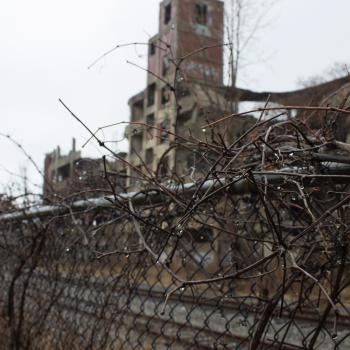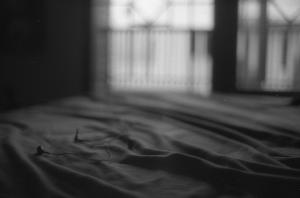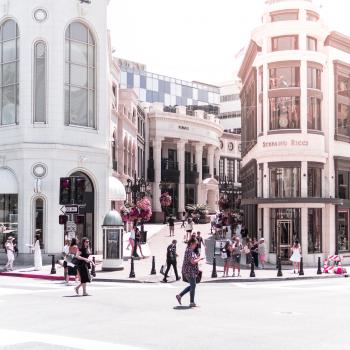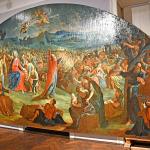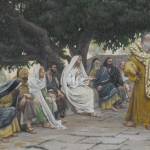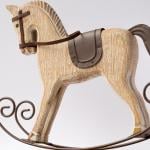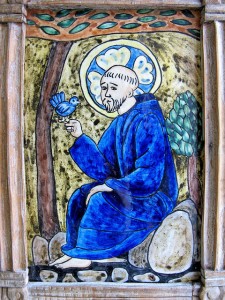 Staying with friends in Silver Lake, Los Angeles for the holidays, I’ve taken to walking down the Micheltorena Street steps in the mornings, ten or fifteen minutes before Mass at eight o’clock. The steps wind down between the houses in the foothills, terminating at Sunset Boulevard. They are forlorn in the way of all empty places within busy cities.
Staying with friends in Silver Lake, Los Angeles for the holidays, I’ve taken to walking down the Micheltorena Street steps in the mornings, ten or fifteen minutes before Mass at eight o’clock. The steps wind down between the houses in the foothills, terminating at Sunset Boulevard. They are forlorn in the way of all empty places within busy cities.
Soon enough, I arrive at Saint Francis of Assisi Church on Golden Gate Avenue, just off Sunset. The church itself is a simple rectangular box of a structure, built of cheap bricks and concrete block. The only adornment is the stained glass: sharp, bold, minimal in a vaguely modernist way. The faces of the saints and biblical figures are rendered almost as cartoons.
Now that Epiphany has come and gone, the inside of the church is bare bones. But I will not soon forget the Christmas decorations. They consisted mostly of scraggly pine trees arranged freestyle around the back of the altar tossed with red and green strings of lights. The lights were on blinking mode. While the old priest was giving his homily, green lights were flashing on one side of his face, red lights on the other. It looked like a bordello.
The other morning at Mass, the celebrant was another elderly Franciscan friar. This one had a stringy white beard and brown sandals. During the hallelujah, he got up from his seat, walked behind the altar, and passed through a doorway at the back of the church. A couple of seconds later we heard a door slam. Then nothing. Minutes passed.
The fifteen or so of us in the pews started to look around. The front of the church was completely empty. After five minutes, it seemed he would not be coming back. Perhaps no one else would come either. What do you do when you’re trapped in a half-finished Mass? A middle-aged Latino couple got up and left.
Finally, we heard a door opening. The friar shuffled back behind the altar. He had a huge wad of toilet paper stuffed in his right nostril and blood smeared on his face and beard. “My nose started bleeding,” he said, and then read the Gospel.
I wanted him to laugh, so that I could laugh too. But he didn’t. So we didn’t.
The bloody-nosed Franciscan then preached his homily about the story in John’s Gospel where Philip encourages his friend Nathanael to come and see Jesus. There results a humorous episode of verbal sparring between Jesus and Nathanael on the nature of truth and seeing. Nathanael is surprised, on approaching, that Jesus already knows who he is.
“How’d you know me?” Nathanael asks Jesus, half expecting a miraculous answer. “Because I saw you sitting under that fig tree with Philip,” is Jesus’s sardonic reply.
In his homily, my bleeding Franciscan did not mention the humor of this Gospel story. He talked about the fact that the Gospels impel us to come and see for ourselves, to find out what this fellow Jesus is talking about and what it might mean for us. It was a good point, a perfectly decent homily.
But he delivered the homily as if he hadn’t just wandered out of the church without telling anyone where he was going. He seemed entirely uninterested in the fact that he left us all in a strange and surreal predicament, wondering what to do in the midst of a suspended Mass. He’d injected a moment of absurdity into the liturgical certainty of the daily Mass.
Slowly, it dawned on me. This had been a particularly Franciscan thing to do. His action was his real homily. What he was doing, not what he was saying. In his book on Saint Francis, G. K. Chesterton wrote that Francis was:
One of the strongest and strangest and most original personalities that human history has known. He was, among other things, emphatically what we call a character; almost as we speak of a character in a good novel or play. He was not only a humanist, but a humorist; a humorist especially in the old English sense of a man always in his humor, going his own way and doing what nobody else would have done.
Some Franciscans (and not all of them, by any means) are able to pull-off the trick whereby they inject a sense of absurdity into the highest things without belittling them. Francis was a master of this trick. And my bloody-nosed friar had done a fair job of following the master.
It is easy to be light with the Mass, to ridicule it, if it is something in which you do not believe. But this Franciscan friar has dedicated his entire life to prayer, worship, liturgy. He is nothing if not serious.
And yet, he walked out of that Mass—strolling out of the church to tend to his nosebleed, returning in his own due time. It was a small-scale act of mastery and freedom. We would wait. The Mass would wait. God, even, would wait.
When I walked up to take Holy Communion I locked eyes with him for a second or two. I thought I might detect a glint of amusement. But he was staring right at the host. Intent, involved, priestly as can be.
Morgan Meis is the critic-at-large for The Smart Set (thesmartset.com). He has a PhD in Philosophy and has written for n+1, The Believer, Harper’s Magazine, and The Virginia Quarterly Review. He won the Whiting Award in 2013. Morgan is also an editor at 3 Quarks Daily, and a winner of a Creative Capital | Warhol Foundation Arts Writers grant. A book of Morgan’s selected essays can be found here. He can be reached at [email protected].
Photo by Randy OHC, used under the Creative Common License


